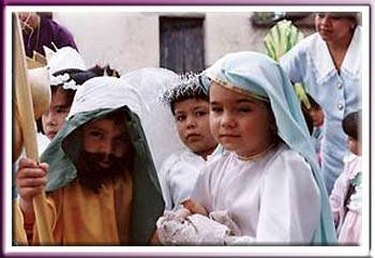
How Does a Mexican Christmas Differ From an American Christmas?
Christmas in Mexico bears only a slight resemblance to an American Christmas. Both Holidays remain grand events in their respective cultures and both are based on the celebration of the birth of Christ Jesus; however, this is where the major similarities conclude. While both countries regard December 25th as the observed date of the event, Mexican Christians focus their celebration on the evening before, December 24th. Christmas Eve in America is still respected as a holy day, but contemporary Christians usually spend this day in preparation for the next. La Navidad, December 25th in Mexico, is considered a holiday but not to the extent of the previous evening.
The Nativity
Video of the Day
In North America, Christmas has evolved from primarily a Christian holiday, celebrating Christ's birth, to a more secular festivity regarding an acknowledgment of good will and generosity. The icon of Saint Nicholas has replaced religious symbols of Christ, and traditions such as the decoration of the evergreen tree and the hanging of stockings and mistletoe have opened the celebration to persons of all beliefs. In Mexico, Christians remain true to their observance of religious faith and regard the Nativity scene (the depiction of the manger where Christ was born) as the main icon for the holiday.
Video of the Day
"La Posadas"
In many Mexican villages, the community comes together to participate in "La Posadas." La Posadas is a nine-day celebration from the 16th of December to Christmas Eve. Each night, two members of the village are selected to represent Mary, the virgin mother of Jesus and her husband, Joseph. Everyone dresses as part of the nativity scene and the neighborhood houses take turns playing the Inn as the two weary travelers beg for a room for the night. In some villages, this procession takes place every night--in others, only on Christmas Eve.
The Festivals
At the end of each night of La Posadas, everyone gathers at church for mass. Although the mass itself is not unlike any other daily service, afterward the entire congregation gathers for a festival where they can gather and sing and enjoy refreshments including sweet and spicy tamales and buñuelos. Activities can include the breaking of a star-shaped piñata and fireworks.The week's activities end as the children are secretly visited by the three magi (wise men) who bring treats and gifts for each member of the household.